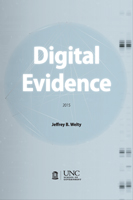
I’m happy to announce that my book on digital evidence is now available. There are five chapters, covering (1) search warrants for digital devices, (2) warrantless searches of digital devices, (3) law enforcement access to electronic communications, (4) tracking devices, and (5) the admissibility of electronic evidence.
The book has been in the works for some time, and many readers of this blog have contributed to my thinking about the issues it addresses. I am grateful for your input. The book is meant to be useful to judges, lawyers on both sides, and officers.
AOC purchase. The Administrative Office of the Courts recently purchased copies of this book and will distribute them to the following judicial officials:
- Judges (Chief and Resident District, Resident and Special Superior)
- District Attorneys and Assistant District Attorneys
- Magistrates (all)
We are awaiting final word from the Office of Indigent Defense Services, which is considering a purchase as well.
According to the AOC, its distribution process will begin the week after receipt and should be complete by mid-June 2015. Books will be delivered with regular supply orders. Please direct questions about AOC distribution among judicial personnel to Joe Slate at 919-890-1532.
Individual purchases. If you think that you might be interested in the book, check out the School of Government web page for it here. The page allows you to preview the table of contents, preface, and introduction, so you can get a sense of what’s in the book before deciding whether to buy it. If you decide you can’t live without it — which of course I hope you do! — you may order online or by contacting the School of Government Bookstore Manager at 919-966-4120. The book costs $50.
As always, I welcome feedback on my work. I plan to update the book periodically, and readers’ comments will help make those updates better and more useful.

